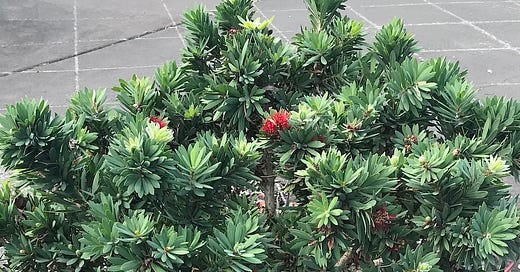There’s been a flurry of posts on social media about a “bold plan” to plant habitat in Brisbane. Here’s a link to the media release so expect it to read like one. I couldn’t find any resulting news stories, maybe that’s my poor research, or maybe it is indicative of something else.
Anyway, these one million plants are spread over nine years and “up to 500 hectares of urban wildlife habitat, including the restoration of wetlands and riverbanks across Brisbane will be reinstated.”
Well, good on them. It’s better this happens than not and I’m not for a moment saying that it shouldn’t happen.
What I see though, is another example of how politicians of all flavours want bold projects with big numbers, ribbon-cutting, and photo opportunities holding a spade looking like they’ve planted a tree. It’s the way politics works, it’s how they get attention and stories in the media.
And it sounds impressive. 500 hectares!
And yet, if half the residents of the same council area planted out their verge garden how much land do you think that would cover?
If you look at the 2021 census there are over 500,000 private residences in the Brisbane council area.
My verge garden is 58sqm. Some are smaller, many are larger, especially in the mid and outer suburbs.
So, on a conservative estimate, if half those residences planted an average of just 20sqm (or 1 in 4 planted 40sqm) that would work out to…. 500 hectares.
Get your spreadsheets out and have a play.
And then, there are the private gardens inside the fence. If some of those residents also started planting habitat gardens, gardens for wildlife, how many more hectares might we get - all connected by those verge garden corridors.
Size matters for funding too. Traditional methods of funding and management need scale. Big lumps of land. Big projects. Even the Land for Wildlife programs are only interested in residents with more than 0.5 hectares (i.e. 5000m2) of land.
Nobody is interested in our 400, 600, or even 800 sqm suburban block. It’s not big or bold or newsworthy. It’s the effective and incremental change using the resources we have at hand. What’s more, the distributed labour of individual residents and community groups means that it could be done in less than a year if we all get cracking.
The desire for big, bold, shiny things doesn’t just apply to planting. It applies to transport - think of all the highway upgrades and overpasses that are election promises. And our big houses and big vehicles. And the Olympics. All huff and puff and all sides of politics.
Meanwhile, I’m happy for them to get on with their 500 hectares by 2032. It will probably be spread across a few large and very impressive projects but won’t reach down to regenerating my local park to protect the platypuses or all the little parklets dotted around the suburbs.
The accumulation of all those little projects has the potential to make the biggest, fastest, and most widespread difference in the face of urban heat and biodiversity loss. And these are projects that don’t just plant and forget but have community involvement for ongoing care and improvement built into the plan.
As we head to an election year for both local and state governments next year, I want to hear about the big, bold budgets to support a myriad of small localised regenerative planting projects to be done in collaboration between state and local governments and businesses and the community.
Just imagine how much shade and biodiversity we could add throughout entire communities with the money they squander on the big bold flyovers, big intersections, and big road upgrades.
So, how many square metres will you plant this month? If you don’t have a verge, there are often local group projects to join.
Imagine if this Christmas, instead of having plastic and tinsel decorations in our streets, we have corridors of native verge gardens and street trees. Shady Lanes to walk along. How’s that for a big, bold, plan?
This Callistemon “Little John” on my verge is a perfect Christmas decoration.




